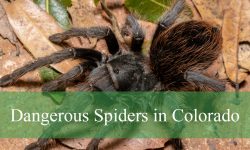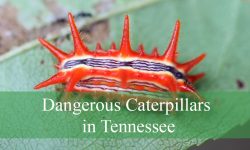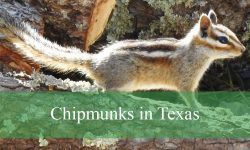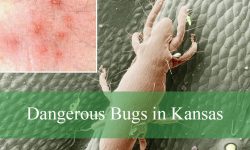Illinois may not seem like prime lizard territory, yet its southern landscapes and sunlit prairies provide the perfect environment for these reptiles to thrive. From the legless Slender Glass Lizard to the quick-footed Six-lined Racerunner, each species reveals a unique adaptation to the state’s varied terrain.
Some lizards bask on fence posts, others hide beneath leaves or rocks, blending perfectly with their surroundings. Their behaviors, colors, and movements tell stories of survival in the woodlands, grasslands, and rocky outcrops of Illinois.
Spotting a lizard in Illinois is a rewarding moment for any nature enthusiast, offering a glimpse into a lesser-known world of reptiles that quietly play vital roles in the local ecosystem. This guide explores the eight lizard species found across the state, complete with identification tips, habitats, and observation insights.
Different Types of Lizards Found in Illinois
Slender Glass Lizard (Ophisaurus attenuatus)
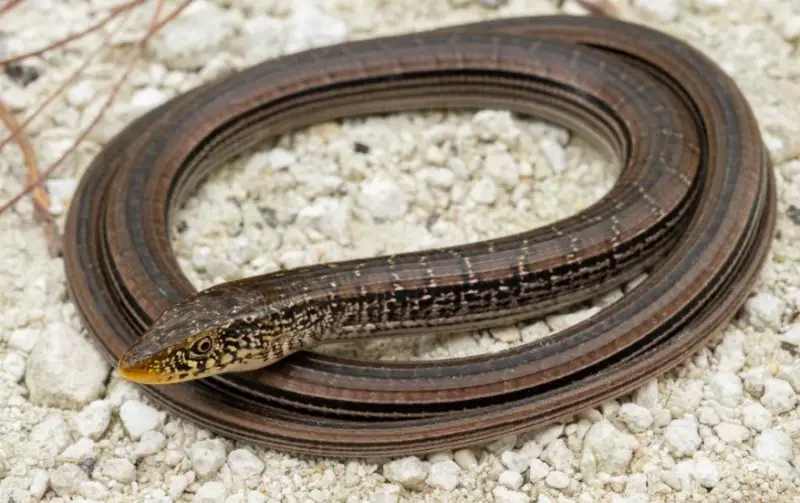
The Slender Glass Lizard is one of the most fascinating reptiles in Illinois because, at first glance, it appears to be a snake. However, it’s actually a legless lizard, distinguished by its movable eyelids, external ear openings, and the ability to break off its tail as a defense mechanism — a trait common among true lizards but absent in snakes. Adults can reach lengths of 22 to 42 inches, with more than half of that length being the tail itself.
In terms of coloration, this species typically displays a tan or light brown body with dark lateral stripes running down its sides. The underside is usually pale yellow or cream. Unlike snakes, the body of the Slender Glass Lizard is somewhat stiff and less flexible, giving it a slightly different movement pattern when it glides through grass or leaf litter. Juveniles tend to have more distinct markings that fade as they mature.
Behaviorally, the Slender Glass Lizard is secretive and spends much of its time hidden beneath debris, logs, or grass clumps. It is primarily active during warm daylight hours and is most often seen after rain or early in the morning. When threatened, it may thrash violently and shed its tail to escape predators — an ability that has earned it the “glass” name due to the way the tail breaks cleanly, as if made of glass.
This species is insectivorous, feeding mainly on grasshoppers, beetles, spiders, and small invertebrates. It hunts by sight and prefers open habitats where visibility is good. Unlike snakes, it cannot unhinge its jaw, so it preys only on small animals it can swallow whole.
In Illinois, the Slender Glass Lizard occurs primarily in the southern and western parts of the state. It favors dry, sandy grasslands, prairies, and open oak woodlands. Due to habitat loss and fragmentation, its population has become more localized, and it is now considered uncommon in many regions where it once thrived.
Eastern Fence Lizard (Sceloporus undulatus)
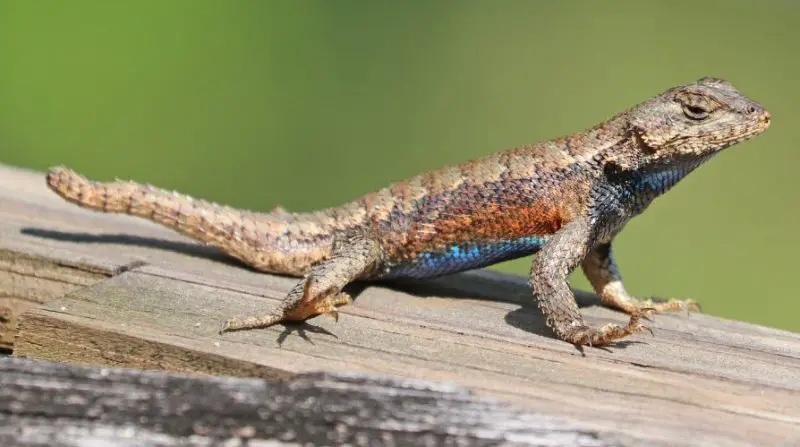
The Eastern Fence Lizard, also known as the Prairie Lizard, is one of Illinois’s most visually striking reptiles. Its rough, spiny scales give it a rugged texture, and males exhibit bright blue patches on their throats and bellies during the breeding season. The body color varies from gray to brown with wavy dark lines running across the back. Adults typically measure between 4.5 and 7 inches in total length, including the tail.
Identification is easy once you notice the spiny texture and the distinct blue patches on males, which they use to signal territorial dominance and attract mates. Females and juveniles are duller, with faint crossbands and no bright coloring underneath. When basking, this lizard’s scales glisten slightly, providing a subtle camouflage against bark and rocky surfaces.
Behaviorally, the Eastern Fence Lizard is diurnal and highly active in warm, sunny weather. It can often be seen basking on rocks, fence posts, or fallen logs, darting away quickly if approached. Males are territorial and engage in head-bobbing or push-up displays to warn rivals or attract females. In cooler mornings, they rely heavily on basking to raise their body temperature before foraging.
Their diet consists mainly of ants, beetles, spiders, and other small insects. They use quick bursts of speed to chase down prey and rely on keen eyesight to detect movement. These lizards are an important part of the ecosystem, helping control insect populations.
In Illinois, the Eastern Fence Lizard is most common in the southern one-third of the state. It thrives in open, rocky woodlands, glades, and forest edges where sunlight reaches the ground. Populations tend to cluster around the Shawnee Hills and Ozark Plateau, where their preferred dry, sandy soils and basking sites are abundant.
Six-lined Racerunner (Aspidoscelis sexlineata)
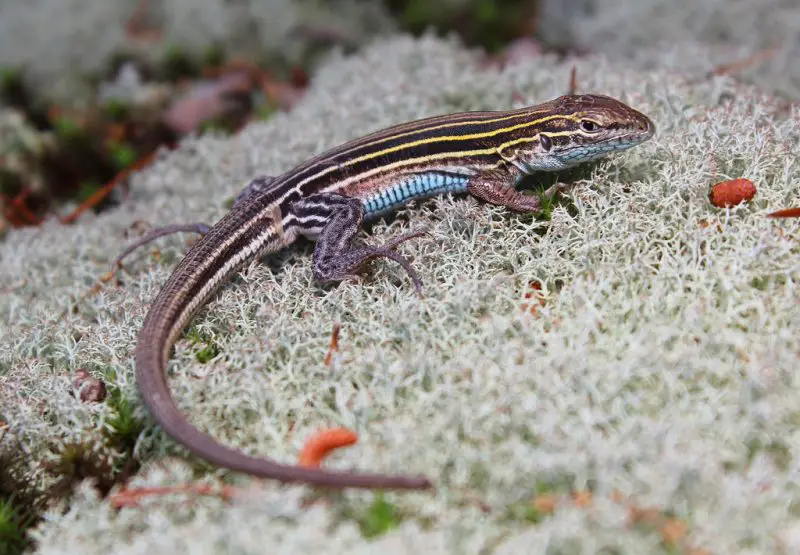
The Six-lined Racerunner is one of the most energetic lizards in Illinois, famous for its incredible speed and alert nature. It has a slender, elongated body with six distinct light stripes running from head to tail over a dark green or black background. Adults typically reach lengths of 6 to 10 inches, including the tail, and have long hind legs adapted for sprinting.
The stripes are the key to identifying this species, as they remain visible even in juveniles. Males often have a faint greenish tint on the back and blue coloration on the throat and belly during the breeding season. Their smooth scales and pointed snout make them easily recognizable among Illinois’s reptile fauna.
Racerunners are aptly named for their speed; they can sprint at impressive rates to evade predators or chase down prey. These lizards are diurnal and spend most of their time in open sunlight, darting across sandy soil or rocky surfaces. When startled, they run in short, rapid bursts and often dive under vegetation or burrows to hide.
Their diet consists mainly of insects such as grasshoppers, crickets, and spiders. They are opportunistic feeders, constantly searching for movement on the ground. Their sharp reflexes and keen eyesight make them effective hunters, capable of detecting even the smallest motion in their surroundings.
In Illinois, the Six-lined Racerunner inhabits sandy prairies, rocky hillsides, and open grasslands, especially in the southern half of the state. Populations are most stable in regions with loose, well-drained soil and sparse vegetation. They prefer warm, dry conditions and are rarely seen during cooler months, retreating underground during cold or wet weather.
Common Five-lined Skink (Plestiodon fasciatus)
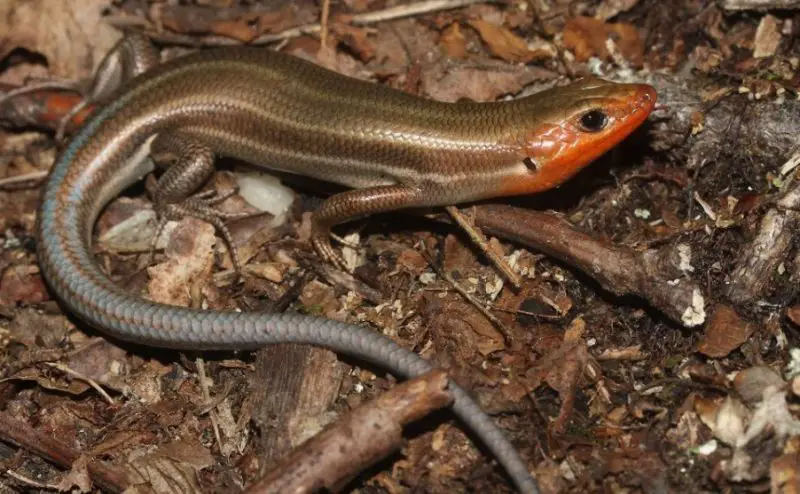
The Common Five-lined Skink is one of the most widespread and recognizable lizards in Illinois. It has a glossy, smooth-scaled body with five light stripes running down a dark brown or black background. Juveniles are particularly eye-catching, with bright blue tails that gradually fade as they mature. Adults typically reach lengths of 5 to 8.5 inches.
Identification is straightforward thanks to the combination of stripes and the blue tail in young individuals. Adult males lose much of the bright coloration and may develop a reddish or orange tint around the jaws during breeding season. The scales are shiny and overlap tightly, giving the skink a polished appearance that helps it slip through leaf litter easily.
Behaviorally, the Common Five-lined Skink is a ground-dwelling lizard that spends much of its time hidden under rocks, logs, or debris. It is diurnal and most active during the warmest parts of the day. When threatened, it quickly retreats into cover or may shed its tail as a defense mechanism. Despite its small size, it’s agile and wary, making it difficult to capture or observe closely.
This species primarily feeds on small invertebrates such as crickets, beetles, spiders, and earthworms. It plays a vital role in controlling insect populations in forested areas. The skink’s feeding activity is concentrated around rotting logs and leaf litter, where insect density is highest.
In Illinois, the Common Five-lined Skink is found statewide but is most abundant in southern and central regions. It prefers moist woodlands, forest edges, and areas with plenty of cover such as logs, rocks, or brush piles. Its adaptability allows it to thrive in both natural and semi-urban environments where shelter and warmth are available.
Broad-headed Skink (Plestiodon laticeps)
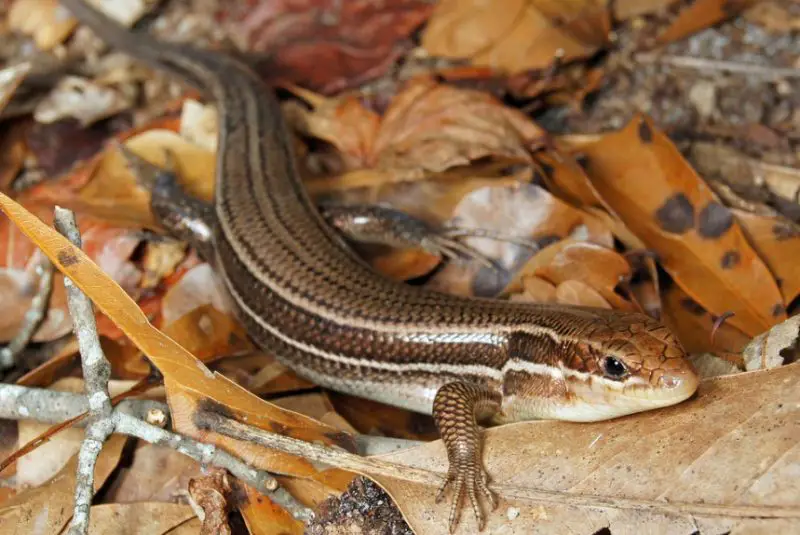
The Broad-headed Skink is the largest skink species in Illinois and one of the most visually distinctive. Adult males develop bright orange or red heads during the breeding season, while females and juveniles retain the characteristic five light stripes seen in other skinks. The body is sleek and muscular, with smooth overlapping scales that shine in the sunlight. Adults typically measure between 6 and 13 inches in total length.
Identification is straightforward once you notice the male’s large, triangular head and strong jaws, which are especially pronounced in mature individuals. Their coloration varies from olive-brown to dark gray, often with subtle blue or green tints on the back. Juveniles resemble the Common Five-lined Skink but can be distinguished by their larger size and broader head as they mature.
In terms of behavior, Broad-headed Skinks are semi-arboreal and excellent climbers. They are frequently seen basking on fallen logs, tree trunks, or branches during the warmer months. Males are territorial and may engage in short chases or displays when confronted by rivals. They are also known to bite when handled, making them one of the more defensive lizards in the region.
Their diet consists of insects, spiders, small invertebrates, and occasionally smaller lizards. They rely on quick reflexes and stealth to ambush prey. During hot summer days, they may become less active, retreating to shaded or moist areas until temperatures drop.
In Illinois, Broad-headed Skinks are primarily found in the southern and southwestern regions, including the Shawnee National Forest area. They prefer moist woodlands, forest edges, and areas with fallen trees or stumps that provide cover. Their climbing ability allows them to exploit habitats not commonly used by other lizards, such as tree canopies and shrubs.
Little Brown Skink (Scincella lateralis)
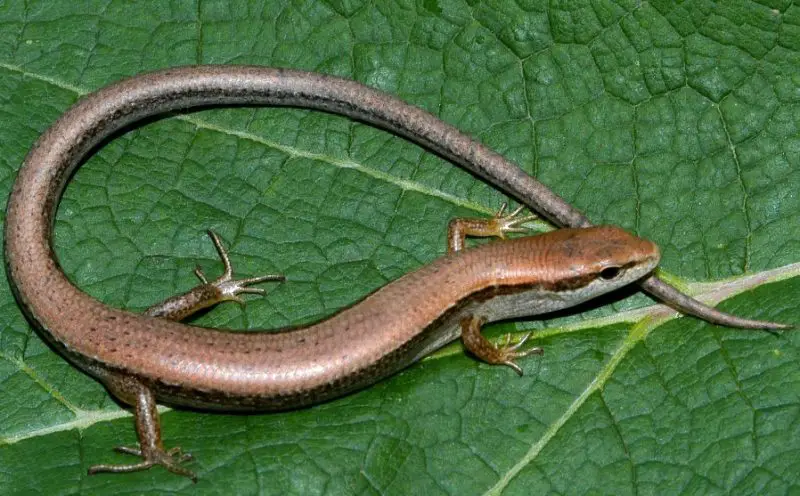
The Little Brown Skink, also known as the Ground Skink, is one of the smallest reptiles in Illinois. Adults usually measure between 3 to 5.5 inches long, including the tail. It has a slender, smooth body covered in shiny, bronze-brown scales with a darker stripe running down each side. Its small size and earth-toned coloration provide excellent camouflage among leaf litter and soil.
Identification is fairly easy once you observe its size and behavior. The Little Brown Skink has a pointed snout, small legs, and a long, thin tail. Its belly is lighter — often cream or silvery white — and its eyes appear large in proportion to its head. Unlike many skinks, it rarely climbs and spends nearly all of its life on or below the ground.
Behaviorally, this species is secretive and prefers to stay hidden under logs, rocks, or forest debris. It’s diurnal but often remains concealed, making it one of the most rarely observed lizards in Illinois despite being locally common. When disturbed, it moves with surprising speed, disappearing into leaf litter almost instantly.
Its diet includes small insects, spiders, and soil-dwelling invertebrates such as termites and beetle larvae. The Little Brown Skink hunts primarily by scent and movement, relying on its tongue and acute vision to locate prey close to the ground.
In Illinois, this species is found mainly in the southern half of the state, particularly in moist deciduous forests and wooded hillsides. It prefers shaded environments with loose soil and abundant ground cover. Because of its cryptic lifestyle, it often goes unnoticed even in areas where it is abundant.
Eastern Collared Lizard (Crotaphytus collaris)
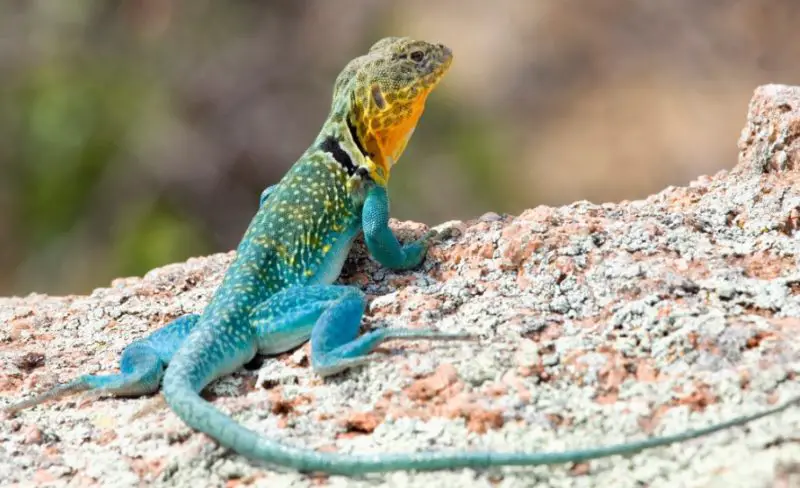
The Eastern Collared Lizard is one of the most colorful lizards ever recorded in Illinois, though it is not native and has limited distribution. Males are striking, with vivid green or turquoise bodies, yellow throats, and two distinct black “collar” bands across the neck. Females are less vibrant but share the same basic pattern. Adults range from 8 to 14 inches long, including the tail.
Identification is unmistakable due to the bold collar markings and the combination of bright coloration with a muscular body and long tail. The head is large and angular, giving the species a fierce appearance. Their scales are small and granular, allowing flexibility and speed during movement.
Behaviorally, Eastern Collared Lizards are highly territorial and extremely active during the day. They are strong runners capable of sprinting on their hind legs for short distances — a unique trait among Illinois lizards. Males often bask on rocky outcrops, watching for both prey and rivals, while females spend more time foraging.
Their diet is carnivorous, consisting primarily of insects, spiders, and smaller lizards. They are visual hunters, relying on movement to detect prey. In captivity and wild studies, they have also been observed eating berries or plant material on rare occasions.
In Illinois, this species was introduced to certain rocky areas in the southern part of the state, including Johnson and Union counties. However, it is considered non-native and may not have established stable, self-sustaining populations. It thrives best in dry, rocky habitats similar to its native range in the southwestern United States.
Mediterranean Gecko (Hemidactylus turcicus)
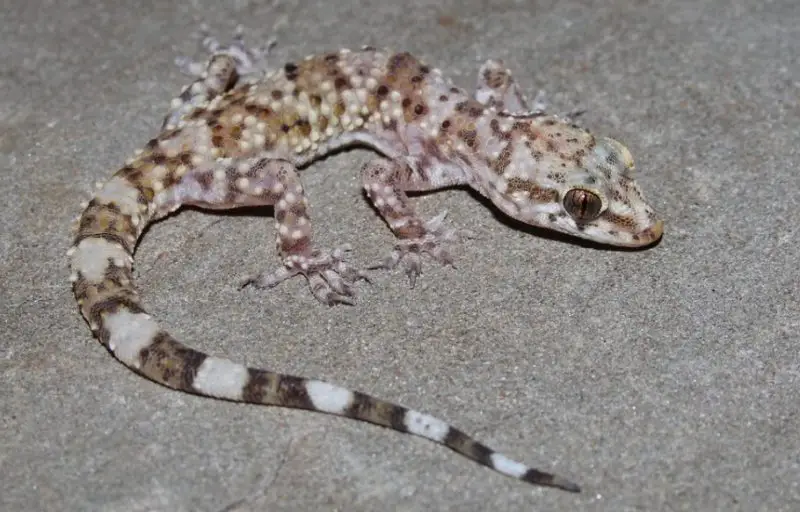
The Mediterranean Gecko is a small, nocturnal lizard native to southern Europe and North Africa but now found in many warm regions of the United States, including parts of southern Illinois. Adults typically measure between 3.5 and 5.5 inches in length. They have translucent, pale pinkish or grayish skin with darker spots and large lidless eyes that reflect light at night.
Identification is easy once you spot one clinging to a wall or window near artificial lights after dark. This gecko’s toe pads are equipped with specialized adhesive structures that allow it to climb smooth vertical surfaces, including glass. Its skin texture is soft and somewhat granular, and its tail is often thick and segmented.
Behaviorally, Mediterranean Geckos are entirely nocturnal and thrive in urban and suburban environments. They are often seen hunting insects around outdoor lights, walls, and ceilings during warm evenings. During the day, they hide in cracks, behind shutters, or under rocks.
Their diet mainly includes moths, flies, mosquitoes, and small arthropods attracted to lights at night. Unlike native Illinois lizards, which are mostly active during the day, this species fills a nighttime ecological niche, helping to control insect populations around human dwellings.
In Illinois, Mediterranean Geckos have established small populations in southern cities such as Carbondale and surrounding areas. They prefer warm, sheltered environments with access to man-made structures. Because they cannot tolerate long freezes, their presence is restricted to the southernmost parts of the state where winters are milder.
Best Time and Places to See Lizards in Illinois
The best time to observe lizards in Illinois is during the late spring through early fall, typically from April to September. These months provide the warm temperatures lizards need to regulate their body heat and remain active. During cooler months, most species become inactive or go into brumation (a reptilian form of hibernation), hiding under logs, soil, or rocks to survive the winter.
The morning and late afternoon hours are the ideal times to spot lizards basking on rocks, fence posts, logs, or sunny patches of ground. In the heat of midday, many retreat to shaded areas to avoid overheating. After a light rain, some species like the Slender Glass Lizard and Six-lined Racerunner become more visible as they emerge to hunt insects.
For the best viewing opportunities, head to southern Illinois, particularly the Shawnee National Forest, Mississippi River bluffs, and rocky woodlands in Jackson, Union, and Johnson counties. These areas provide a mix of sandy prairies, open forests, and rocky outcrops that support the state’s richest lizard diversity. The Little Egypt region of Illinois, known for its warmer climate and diverse terrain, offers prime habitat for skinks, racerunners, and fence lizards.
In central Illinois, the Common Five-lined Skink can sometimes be found near wooded parks, old farmsteads, and nature preserves with decaying logs or leaf litter. Urban sightings of the Mediterranean Gecko occur mostly in southern towns, where they cling to buildings near outdoor lights at night. Always use binoculars or a zoom lens to observe them respectfully, avoiding capture or disturbance.
FAQs About Lizards in Illinois
What is the most common lizard in Illinois?
The Common Five-lined Skink (Plestiodon fasciatus) is the most widespread and frequently encountered lizard in Illinois. It thrives in forests, woodlands, and even near human structures. Its blue-tailed juveniles are often spotted scurrying through leaf litter or basking on logs during warm months.
Are there legless lizards in Illinois?
Yes. The Slender Glass Lizard (Ophisaurus attenuatus) is a legless species native to Illinois. Though it looks like a snake, it can be identified by its movable eyelids and external ear openings. It is most often found in sandy prairies and dry grasslands in the southern part of the state.
Are any Illinois lizards dangerous to humans?
No lizards in Illinois are dangerous or venomous to humans. Even the larger species, like the Broad-headed Skink, may bite defensively if handled but pose no real threat. Most lizards are shy, non-aggressive, and quick to flee when approached.
Where can I see lizards in Illinois?
The best places to see lizards include Shawnee National Forest, Ferne Clyffe State Park, Trail of Tears State Forest, and Pine Hills Nature Preserve. These protected areas provide the rocky and wooded habitats that species like the Eastern Fence Lizard and Six-lined Racerunner prefer. For nocturnal viewing, check walls and lighted buildings in southern towns to spot the Mediterranean Gecko.
When are lizards most active in Illinois?
Lizards are most active during warm daylight hours from May through August. Morning basking periods and late-afternoon foraging times are ideal for observation. On cool or rainy days, their activity decreases, and they often remain hidden beneath cover.
Are any Illinois lizards endangered or protected?
The Slender Glass Lizard is considered a species of concern in Illinois due to habitat loss and fragmentation. While not federally endangered, it is rare in many parts of its range. Conservation efforts focus on preserving open prairie and sandhill habitats where this species survives.
Do lizards live in northern Illinois?
Lizards are uncommon in northern Illinois due to cooler temperatures and lack of suitable habitat. The Common Five-lined Skink occasionally extends its range into central and northeastern areas, but most other species are restricted to southern and southwestern Illinois where the climate is warmer.
Can lizards survive Illinois winters?
Yes, but only by entering brumation, a state of dormancy similar to hibernation. They burrow underground, hide under logs, or take shelter in crevices to escape freezing temperatures. Activity resumes in spring once soil and air temperatures rise above 60°F (16°C).
What should I do if I find a lizard around my home?
If you find a lizard near your home, it’s best to leave it undisturbed. Lizards are beneficial because they feed on insects and spiders. You can make your yard more lizard-friendly by maintaining natural cover such as rocks, logs, and native vegetation, while avoiding pesticides.
Are lizards protected by law in Illinois?
Most lizards in Illinois are not specifically protected, but it is illegal to collect or harm wildlife on state or federal lands without a permit. Ethical observation and photography are always encouraged over capture or handling.

